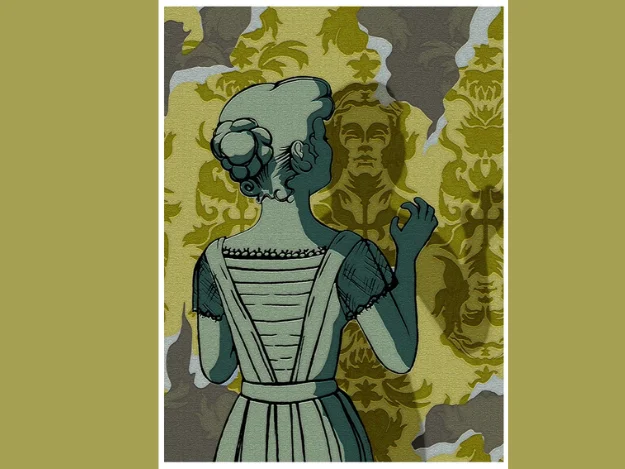
The Yellow Wallpaper - A Woman's Descent into Madness
by Celia B
The Yellow Wallpaper is a short story about a woman’s descent into madness as she becomes obsessed with the patterns in her bedroom’s wallpaper Charlotte Perkin Gilman’s story explores themes of isolation ,mental illness,and repression.I like how it pulls you into the narrator's thoughts. The story’s portrayal of mental illness, society repression ,and the dangerous consequences of silencing women's voices is both very interesting and hard to understand . It is hard to read but also its intensity is pretty high.However it is still a gripping piece that makes you want to read more and it is very interesting.
The Yellow Wallpaper is significant for several reasons .It shows the way women’s mental health was often dismissed and/or misunderstood in the late 19s.The story is shows that the government was assuming that women were fragile or incapable of managing their own lives and that they needed “help” from their husbands.The themes are ,gender roles, autonomy ,because for the government , women cant handle their “problems". The pressure that a lot of women had to go through because they were “not normal“ is also a very interesting subject brought up by this short story.
In conclusion this story is an essential read to learn about mental health andfeminism.
The Yellow Wallpaper can be described as feminist. It highlights the struggles women faced in the late 1890s ,especially when it comes to having control of their bodies and lives. An example is when the main character’s husband makes all the decisions for her, treating her like she can't be trusted or is incapable of anything. She says. ”I wanted one downstairs that opened on the piazza and had roses all over the window, and such pretty old fashioned chintz hanging ! But John would not hear of it“ The narrator expresses her preference for a different room in the house but John doesn't fulfill her wishes completely, choosing the one with the yellow wallpaper . This shows how women were often treated as fragile or incapable people, which is a big theme in feminist books. The narrator’s mental decline is directly tied to her lack of autonomy and her forced confinement. She is not allowed to make decisions about her own life, even though she is aware that writing and mental stimulation would help her. We see her frustration when she says, “I did write for a while in spite of them; but it does exhaust me a good deal, having to sly about it, or else meet with heavy opposition,” The narrator believes writing would help her but she must do it secretly because John forbids it.The act of hiding her writing and suppressing her creativeness contributes to her mental deterioration . Her voice is constantly invalidated by her husband, a symbol of male authority. This reflects broader societal expectations, and the idea that women need to rely on men, a big theme in feminist critique .
In The Yellow Wallpaper, Gilman does not only highlight the oppressive treatment of women , mostly in the context of mental health but also makes people want to change by exposing the consequence of such mistreatment .The story serves as a direct critique of the “rest cure” and other bad things they are doing to women ,illustrating how they can harm women both mentally and physically. Gilman, who experienced the “rest cure“ herself, used the story to promote a more progressive understanding of women’s needs. She also engaged in efforts to bring about change in medical practices so they can stop this “confinement “.
Gilman is clearly making a point that the husband, and Dr. Silas Weir Mitchell, who developed this treatment, are wrong. The husbands insistence on controlling the narrator's treatment ,while not listening to her needs , shows how patriarchal structures harm women by denying their autonomy. Gilman uses exaggerated imagery ,such as the narrator growing obsession with the wallpaper and her eventual breakdown ,to show the extreme mental and emotional damage caused by the confinement and lack of help. Feminism in this context is about making change.
The story primarily represents middle and upper class white women who were subjected to oppressive treatment within the domestic sphere especially in terms of their mental health and autonomy.The narrator is a woman who has access to medical care and lives in a large house ,suggesting a level of privilege.The feminist critique in the story focuses on the domestic and medical oppression experienced by women in similar social positions , those who were often kept confined home and denied intellectual or creative freedom .
The Yellow Wallpaper represents how the narrator feels trapped in her life, her husband John controls her, believing she is too weak to make decisions for herself. He locks her up in a room and forbids her from writing or doing anything or doing anything creative, thinking it will help her, which ends up making her feel suffocated, and confusion, ugly pattern of the wallpaper becomes frustrating and the more she stares at it the more obsessed and disturbed she becomes.
As the narrator focuses on the wallpaper, she begins to imagine there is a woman trapped behind it, trying to break free.this represents the narrator herself and more generally, how many women felt during that time, stuck and controlled by men and society. The narrator becomes fixated on freeing the women ,which reflects her own desire to escape the situation.
By the end the narrator identifies completely with the woman in the wallpaper showing that her mental health has broken down. Tearing down the wallpaper becomes her way of rejecting the life she's forced to live, even though it leads her to madness.
The overall meaning is that The Yellow Wallpaper and the trapped woman are symbols of how women were not allowed freedom or independence. The story highlights how harmful it is when women are controlled and denied the chance to express themselves .